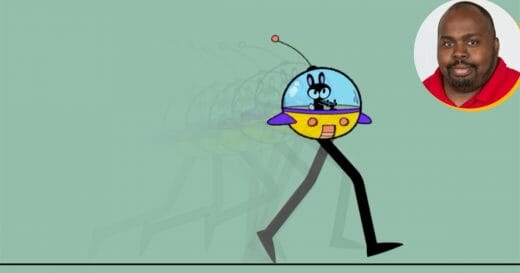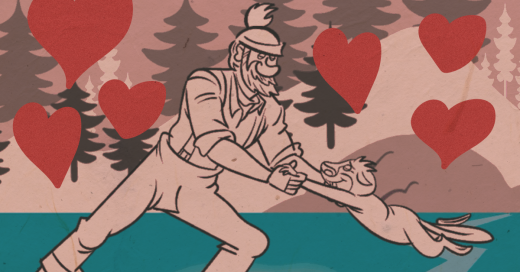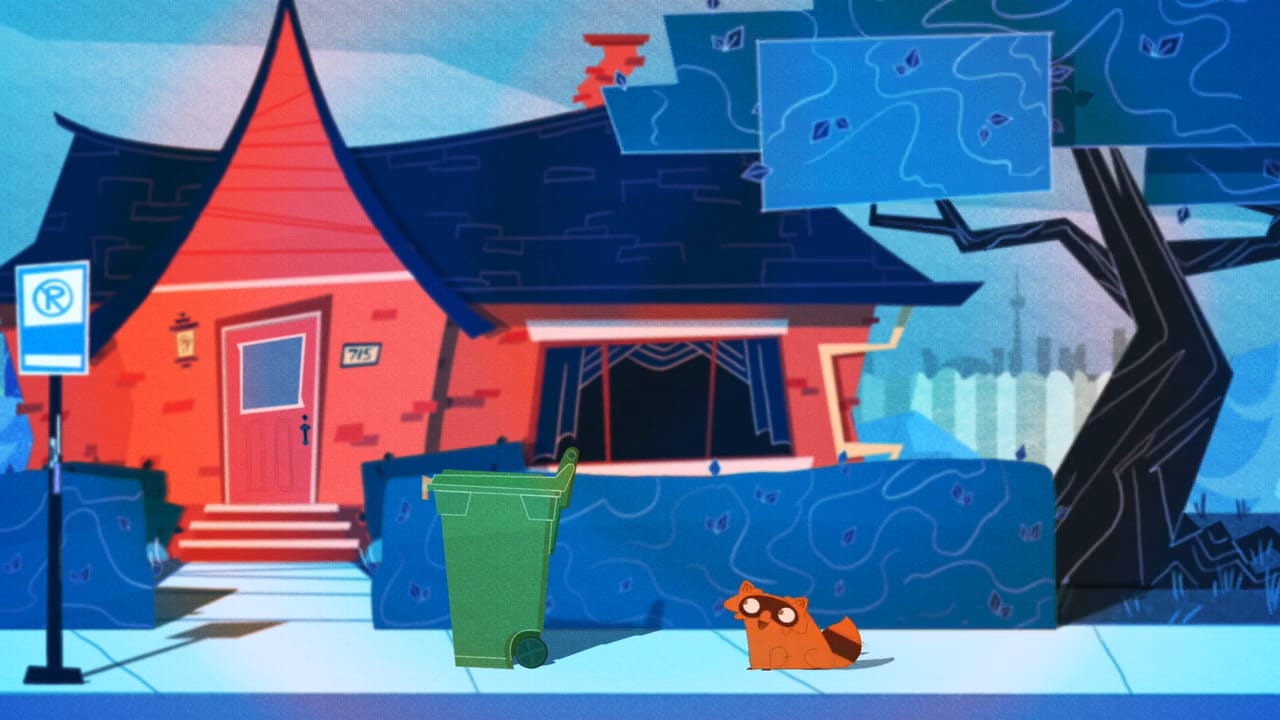
In Jungwoo Choi’s thesis film The Pest, a Toronto homeowner struggles to outwit a raccoon deadset on eating out of his trash bin. The story is inspired by Toronto’s notorious issues, and fascination, with the city’s prodigious raccoon population. Running at over two and a half minutes long, the hilariously relatable turf war escalates to absurdity.
The Pest is an impressive display of Choi’s interest in visual development and character rigging, taking influences from The Ren & Stimpy Show, Foster’s Home for Imaginary Friends, and independent animation projects on YouTube. It was in competition at the Ottawa International Animation Festival (OIAF) where it was a Canadian Student Competition selection, and won the Best 2D Character Animation Award by Brown Bag Films and the Wildbrain Excellence Award for 2D animation.
Jungwoo Choi (who also goes by Woo) took the time to chat with Toon Boom about the nitty gritty of producing an award-winning comedy thesis film.
What did the planning stage for The Pest look like? What inspired you to make a comedy short for your thesis film?
Woo: I came across this CBC video on YouTube. It was about how raccoons are the unofficial mascot of Toronto, and how they thrive in Toronto’s environment.
There were also two stories that really inspired me that I wanted to reference in my film. There was this big Toronto meme that happened: Conrad, the #DeadRaccoonTO. He was this dead raccoon in the middle of the Toronto streets, and people had a grand memorial for this raccoon. There were flowers, written notes, candles, and somebody had a framed picture of a raccoon. Crazy. Hilarious. My family was dying laughing about it.
And then there was the $31 million project in Toronto to make raccoon-proof green bins, which completely backfired because the raccoons were able to figure out how to get through them. I featured those two stories in The Pest with the green bin and naming my [human character] Conrad.
In terms of planning, it was just a lot of researching short film tips on YouTube, watching a lot of short films, and jotting in my notebook, brainstorming ideas. And eventually, the raccoons ust came into my mind.
What did a typical day in production look like for you? Were there other contributors on the project?
Woo: It was a one-man team, basically. I did all of the designing, animating, compositing, pretty much everything in the pipeline. I did hire a composer from the University of Toronto. Her name is Bernadette Choy. Students from the music composition program come to help with our films, and she was one of the students that volunteered. She’s amazing. She got it done very quickly. I’m so glad to have her.
A typical day was all based around the student program. We had specific milestones for each day. We had to have our pitch package made, designs, our storyboard, animatics, all done in the first half of the year – basically, the pre-production.
Then, the next semester, it’s just animating, compositing, and getting this whole film done. Most of the time, it was just me in my home, just being a gremlin, working all day, 24-7. It was pretty busy. And I got it done
That last semester in animation school must be a lot. It’s got to be heavy in that crunch time.
Woo: Yeah, crunch time is real and insane.
I noticed you thanked quite a few people at the end of the credits. Were some of them other key contributors besides your composer?
Woo: There is pretty much everybody that gave me feedback, gave me advice on the film. Big or small, they made a big impact in making this film.
Right on! How’d you go about creating the story?
Woo: Creating the story was just a lot of researching on short films – short films and short film mistakes. I wasn’t a very strong storyteller, so I had to understand the fundamentals of short story. And in the end, the fact that this is my first time constructing my whole film was just a pretty great start for me.
What techniques and programs did you use to make the film?
Woo: I used Photoshop to do all my designs and backgrounds. I used Toon Boom Harmony a lot for animation and compositing, Premiere for editing and a bit more compositing, mainly color correcting, and Adobe Audition for sound editing.
I created this grain tool that I just went in Photoshop and just scribbled around with all the brushes I had and made the texture. Blurs, I found, were really helpful for me in Toon Boom. I think I’ve used mainly Gaussian and just regular blurs.
I think one thing that I found I had issues with was that my colour scheme was very, very saturated. So I found that the characters and the backgrounds competed with each other. By using Blurs on it, it helped the characters pop out of the background. It also gives it a bit of depth, makes it more live action-y.
What were your influences on The Pest? I got a bit of a The Ren & Stimpy Show vibe from the visuals – or SpongeBob Squarepants – particularly with the close-up of the lock-picking claw on the raccoon, and that amazing black and white close-up of Conrad’s evil expression right before he cuts down the tree.
Woo: I have so many influences. I feel like there’s a huge list, but definitely Ren & Stimpy and SpongeBob. You were right that I took inspiration from their grotesque close-ups, their highly detailed images. I thought that’d be so fun and funny.
And I took inspiration from a lot of YouTube animation. The main ones off the top of my mind were Cas van der Pol, Sr Pelo, and Terminal Montage. What all these YouTube channels have in common is they’re very crazy and unhinged and have lots of extreme, exaggerated moments and expressions, which that’s what I really wanted in my film.
I was also inspired by shows like the Mickey Mouse shorts and Foster’s Home ofImaginary Friends for the designs.

Conrad, your human character, has a very distinctive way of moving. His legs are always blurry. He doesn’t move a lot, but when he does, it’s very expressive and very extreme. Was there anything in particular that influenced those choices for him?
Woo: The little fanning motion that Conrad does when he’s walking or running was inspired by SpongeBob. Mr. Krabs, when he’s walking, he does that fan thing with his legs. I got inspired by that.
Something about the way he walks, I imagine his steps kind of sound like a keyboard typing; just like a scramble on the typewriter. It has a bit of that vibe with Conrad. I thought it makes sense to get that fanning animation while also having the keyboard sound, which was the actual noise I made.
Another thing about Conrad is I kind of wanted his character design to resemble trash or something trash-related. So his head resembles the stereotypical silver trash can, something like Oscar the Grouch would live in. That New York grey trash can; I took influence from that.
I took a look at your website and I saw you shared your 2D rigs. They’re incredibly detailed, especially the rigs for Conrad and the raccoon. Of course, Toon Boom Harmony is known for its rigging tools. How would you describe your rigging process?
Woo: During fourth year, I was taking a 2D rigging class with my prof, Sarah Wallace. I used Conrad for my rigging assignments. I learned off of that class and it really benefited me a lot. Then I utilized those skills to make the raccoon, and then the buff dog as well.
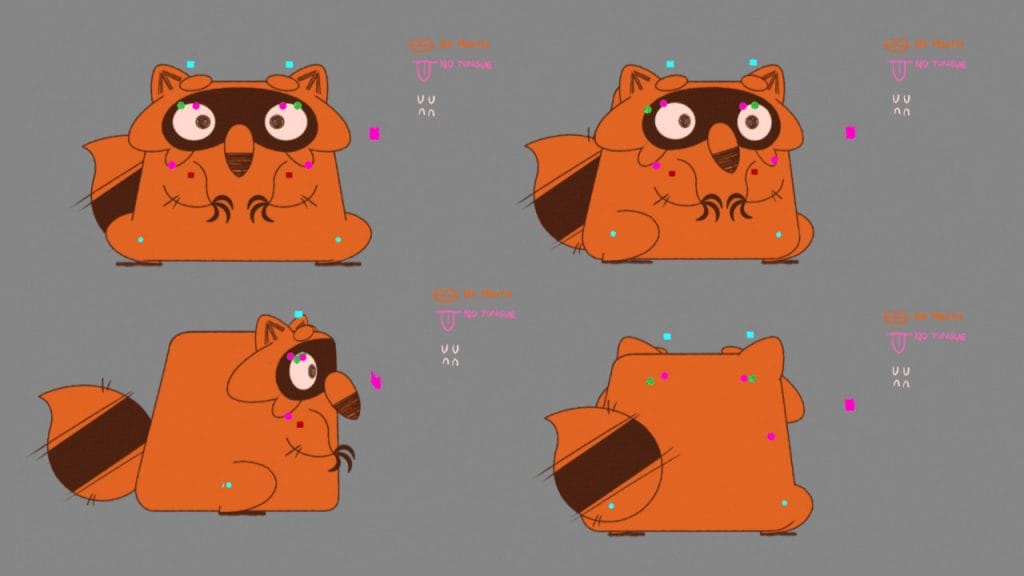
A lot of work went into the character rigs and the visual development. How did you strike that balance of getting such involved rigs and such interesting design within the timeframe you had?
Woo: I definitely knew it was going to be a very intimidating task to do this all by myself. One of my major goals when making my film was to use it as my animation, rigging, and design portfolio piece. I didn’t have any plans on doing backgrounds in the future.
So I thought it would make sense to maybe just do a wide shot of the house and tree, just so I can save some time finishing the backgrounds and prioritize more animation. So in total, I believe, I only did three unique backgrounds. That saved me a lot of time.
And I also definitely reuse a lot of animation. One in particular is the green bin throwing the big pile of trash. I use the same animation for every time that the green bin falls and trash comes out. And I feel that’s what helped me get that balance.
I felt that it had a bit of a stage play quality. It’s like the viewer is a neighbour watching Conrad in this ongoing turf war with a raccoon from across the street. What were some of the challenges you faced during production?
Woo: Definitely figuring out how to contrast the saturated colour schemes of the characters and the backgrounds, which I figured that out with blurs.
I found that because most of my shots revolve around one background animation, the animation shots were pretty long. I think the longest one was 30 seconds. It was pretty heavy, especially in compositing, when you have such a long shot, all those blurs, colour corrections, and overlay and stuff.
You credit Mark Polowich as being your mentor on the project. Was this through a school-run mentorship program? And what effect did he have on the project?
Woo: It was from a school-run thing. In fourth year of Sheridan, everyone is assigned a group with a mentor, and I got assigned Mark.
My prof always emphasizes making it shorter, condensing as much as possible. I think everyone in my group was like, “I can’t reduce this anymore”. But in a way, I think he did us a favour. We don’t have to suffer through unneeded animating and compositing. That’s something I learned which I did benefit a lot from.
Another thing he told me was that, if you’re not sure about the pacing and timing of your animatic, try replaying it at 1.5 speed. I got a better understanding of when things are too long, or when things are too short. I think those are two big things that I learned from him.
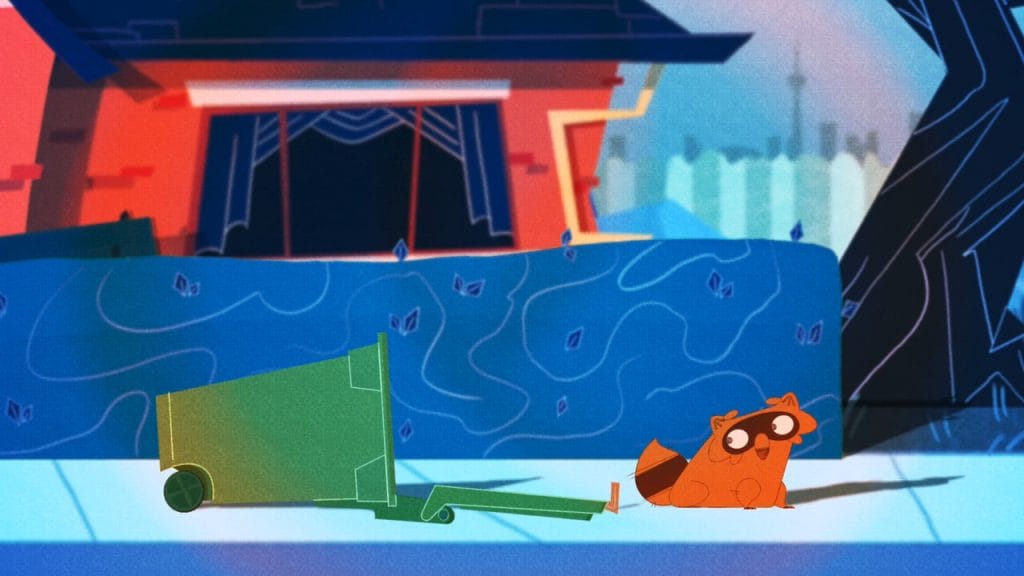
And what’s your advice to students planning their thesis films? Because we have a lot of animation students who read the blog.
Woo: The first thing I would say is to get started as soon as possible. Like before school starts when you have to make your own thesis film. At least get your film ideas set and your script done at minimum. I think that will be a great start to making a great film. The more you prepare before school, the better your film is.
Be mindful about compositing. It’s very time consuming, very tedious – data heavy as well. I would say [anticipate a] minimum two weeks to get that prepared.
I think about reuses a lot. Reusing can save you so much time. I don’t think a lot of people will notice that. They’re just going to enjoy it. Those are the big things I would say.
The Pest was in competition at the Ottawa International Animation Festival, and won multiple awards in other festivals. How would you describe the reaction so far?
Woo: I was a little nervous because it’s a really big animation festival. But when I went to the screening for it, it was pretty overwhelmingly positive. People went wild about it, not gonna lie. Lots of laughs. It was a relief knowing that like, okay, my film is good.
What do you hope to work on moving forward?
Woo: I think I’m just figuring myself out as an artist currently. I’ve just been doing a lot of caricatures, caricature sketches, drawings of different celebrities. And I’ve also been looking into 3D as well. So that’s something I’ve been looking forward to.
And maybe there is a possibility I could make a YouTube series with this film. I have thoughts about it, but I haven’t really had a plan yet on how to go moving that forward. So that’s what’s been happening.
- To see more Jungwoo Choi’s portfolio and character rigs, check out his website. And be sure to follow Woo on Instagram and LinkedIn to learn more about his recent projects.
- Planning your thesis film? Students can get up to 84% discounts on Harmony and Storyboard Pro with student licenses.


